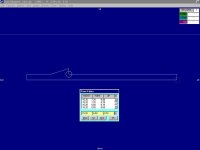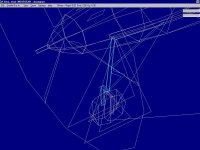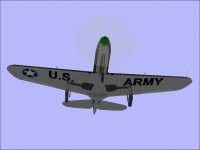Hello All,
I first encountered Eric Johnson's P-39D Airacobra a bit over 15 years ago.
Perhaps it was actually someone else's modification of his original design. It has been so long I can't remember.
This was way before I started building Aeroplanes for Combat Flight Simulator and most models of the time were adaptations of Flight Simulator 98 (or earlier) designs.
I thought the general shape was pretty good even though it was obviously a very low polygon 3D model.
It did have some obvious faults.
Some were obviously a consequence of the low resource count and a possible lack of tools at the time.
The worst fault was that it had "Plain Flaps" while the actual Airacobra had "Split Flaps".
There were a few shape issues the worst of which was the angle of the aeroplane while sitting on the ground.
The Airacobra sits at a very noticeable nose high attitude.
At the time, I was just getting into editing AIR files, so correcting the angle on the ground was not difficult.
The end result was that "my own version" of the Airacobra at that time would always sit with the Nose Wheel hovering a few inches off the ground.
.......
A couple years later not long after I started attempting my own projects with Aircraft Factory 99, I found the AFX for Mr. Johnson's Airacobra. I also found many other AFX's but really had no idea what to do with them.
With Mr. Johnson's Airacobra, I decided to try a few "simple" edits.
The Plain Flaps bothered me the most, so it was the first correction.
The next edit was to replace the 2D Wing Guns with 3D pieces.
After that, I quit. Following the Parts naming convention in EJ's AFX was quite difficult.
That is where things stood for many years. I had an updated Eric Johnson Airacobra on a couple computers but since it was not my own original work (nor was the work that great an improvement), I never uploaded it.
.......
I first encountered Eric Johnson's P-39D Airacobra a bit over 15 years ago.
Perhaps it was actually someone else's modification of his original design. It has been so long I can't remember.
This was way before I started building Aeroplanes for Combat Flight Simulator and most models of the time were adaptations of Flight Simulator 98 (or earlier) designs.
I thought the general shape was pretty good even though it was obviously a very low polygon 3D model.
It did have some obvious faults.
Some were obviously a consequence of the low resource count and a possible lack of tools at the time.
The worst fault was that it had "Plain Flaps" while the actual Airacobra had "Split Flaps".
There were a few shape issues the worst of which was the angle of the aeroplane while sitting on the ground.
The Airacobra sits at a very noticeable nose high attitude.
At the time, I was just getting into editing AIR files, so correcting the angle on the ground was not difficult.
The end result was that "my own version" of the Airacobra at that time would always sit with the Nose Wheel hovering a few inches off the ground.
.......
A couple years later not long after I started attempting my own projects with Aircraft Factory 99, I found the AFX for Mr. Johnson's Airacobra. I also found many other AFX's but really had no idea what to do with them.
With Mr. Johnson's Airacobra, I decided to try a few "simple" edits.
The Plain Flaps bothered me the most, so it was the first correction.
The next edit was to replace the 2D Wing Guns with 3D pieces.
After that, I quit. Following the Parts naming convention in EJ's AFX was quite difficult.
That is where things stood for many years. I had an updated Eric Johnson Airacobra on a couple computers but since it was not my own original work (nor was the work that great an improvement), I never uploaded it.
.......




































